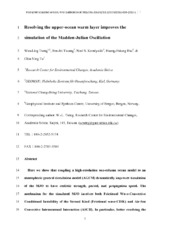| dc.contributor.author | Tseng, Wan-Ling | |
| dc.contributor.author | Tsuang, Ben-Jei | |
| dc.contributor.author | Keenlyside, Noel | |
| dc.contributor.author | Hsu, Huang-Hsiung | |
| dc.contributor.author | Tu, Chia-Ying | |
| dc.date.accessioned | 2016-02-12T08:27:35Z | |
| dc.date.available | 2016-02-12T08:27:35Z | |
| dc.date.issued | 2014-09 | |
| dc.Published | Climate Dynamics 2014, 44(5-6):1487-1503 | eng |
| dc.identifier.issn | 1432-0894 | en_US |
| dc.identifier.uri | https://hdl.handle.net/1956/11196 | |
| dc.description.abstract | Here we show that coupling a high-resolution one-column ocean model to an atmospheric general circulation model dramatically improves simulation of the Madden–Julian oscillation (MJO) to have realistic strength, period, and propagation speed. The mechanism for the simulated MJO involves both frictional wave-convective conditional instability of the second kind (Frictional wave-CISK) and air–sea convective intraseasonal interaction (ASCII). In particular, better resolving the fine structure of upper ocean temperature, especially the warm layer, produces more vigorous atmosphere–ocean interaction and strengthens intraseasonal variations in both SST and atmospheric circulation. This helps organize and strengthen deep convection, inducing a stronger Kelvin-wave like perturbation and frictional near-surface convergence to the east. In addition, the warmer SST ahead of the MJO also acts to destabilize the boundary layer and enhance frictional convergence. These lead to a more realistic eastward-propagating MJO. A suite of sensitivity experiments were performed to show the robustness of the mechanisms and to demonstrate: (1) that mean state differences are not the main contributors to the improved simulation of our coupled model; (2) the role of SST variability in enhancing frictional convergence and intraseasonal variations in precipitation, and (3) that the simulation is significantly degraded when the first ocean model layer is thicker than 10 m. Our coupled model results are consistent with observations and demonstrate a simple but effective means to significantly improve MJO simulation and potentially also forecasts. | en_US |
| dc.language.iso | eng | eng |
| dc.publisher | Springer | en_US |
| dc.subject | MJO | eng |
| dc.subject | Coupling | eng |
| dc.subject | Warm layer | eng |
| dc.subject | One column ocean model | eng |
| dc.title | Resolving the upper-ocean warm layer improves the simulation of the Madden-Julian oscillation | en_US |
| dc.type | Peer reviewed | |
| dc.type | Journal article | |
| dc.date.updated | 2016-02-04T14:45:16Z | |
| dc.description.version | acceptedVersion | en_US |
| dc.rights.holder | Copyright Springer-Verlag Berlin Heidelberg 2014. | en_US |
| dc.identifier.doi | https://doi.org/10.1007/s00382-014-2315-1 | |
| dc.identifier.cristin | 1175777 | |
| dc.subject.nsi | VDP::Matematikk og naturvitenskap: 400::Geofag: 450::Meteorologi: 453 | |
| dc.subject.nsi | VDP::Mathematics and natural scienses: 400::Geosciences: 450::Meteorology: 453 | |
| dc.subject.nsi | VDP::Matematikk og naturvitenskap: 400::Geofag: 450::Oseanografi: 452 | |
| dc.subject.nsi | VDP::Mathematics and natural scienses: 400::Geosciences: 450::Oceanography: 452 | |
| dc.subject.nsi | VDP::Matematikk og Naturvitenskap: 400::Geofag: 450::Petroleumsgeologi og -geofysikk: 464 | en_US |
| dc.subject.nsi | VDP::Matematikk og Naturvitenskap: 400::Geofag: 450::Oseanografi: 452 | en_US |
